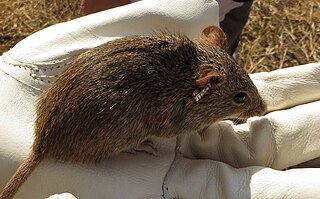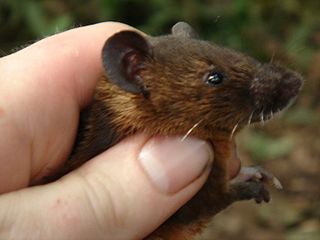
Lemniscomys, sometimes known as striped grass mice or zebra mice, is a genus of murine rodents from Africa. Most species are from Sub-Saharan Africa; L. barbarus is the only one found north of the Sahara. They are generally found in grassy habitats, but where several species overlap in distribution there is a level of habitat differentiation between them.
Bellier's lemniscomys or Bellier's striped grass mouse is a species of rodent in the family Muridae. It is found in Burkina Faso, Ivory Coast, Ghana, Guinea, and possibly Sierra Leone. Its natural habitat is typically a dry savanna region.
Griselda's lemniscomys or Griselda's striped grass mouse is a species of rodent in the family Muridae.
Lemniscomys linulus, commonly known as the Senegal grass mouse or Senegal one-striped grass mouse, is a species of rodent in the family Muridae. It is found in Ivory Coast, Guinea, Mali, and Senegal and its natural habitat is dry savanna. At one time considered to be a subspecies of Lemniscomys griselda, it is now accepted as a species in its own right.
Mittendorf's lemniscomys or Mittendorf's striped grass mouse is a species of rodent in the family Muridae. It is endemic to Cameroon where it is found at high elevations on a single mountain. Its natural habitat is tropical high-altitude grassland. It faces no particular threats and the International Union for Conservation of Nature has listed it as being of "least concern".

The single-striped grass mouse or single-striped lemniscomys is a species of rodent in the family Muridae.
Rosevear's lemniscomys or Rosevear's striped grass mouse is a species of rodent in the family Muridae. It is found in Zambia and possibly Angola, where its natural habitat is cryptosephalum dry forest. The species is threatened by habitat loss.
Heuglin's lemniscomys or Heuglin's striped grass mouse is a species of rodent in the family Muridae. It is found in Benin, Burkina Faso, Chad, Democratic Republic of the Congo, Ivory Coast, Gambia, Ghana, Guinea, Guinea-Bissau, Kenya, Mali, Niger, Nigeria, Senegal, Sudan, Tanzania, Togo, Uganda, and possibly Ethiopia. Its natural habitats are moist savanna, subtropical or tropical moist shrubland, arable land, and plantations.

The rusty-bellied brush-furred rat is a species of rodent in the family Muridae. It is found in Angola, Benin, Cameroon, Central African Republic, Republic of the Congo, Democratic Republic of the Congo, Ivory Coast, Equatorial Guinea, Gabon, Ghana, Guinea, Kenya, Liberia, Nigeria, Sierra Leone, Tanzania, Togo, and Uganda. Its natural habitats are subtropical or tropical moist lowland forests, subtropical or tropical seasonally wet or flooded lowland grassland, arable land, and pastureland.
The tiny fat mouse is a species of rodent in the family Nesomyidae. It is found in Angola, Botswana, Ethiopia, Kenya, Mozambique, Namibia, South Sudan, Tanzania, Uganda, Zambia, and Zimbabwe. Its natural habitats are subtropical or tropical dry shrubland and subtropical or tropical dry lowland grassland.

The yellow-crowned bishop is a species of passerine bird in the family Ploceidae native to Africa south of the Sahara. It is highly sexually dimorphic in its breeding season, during which the male adopts a distinctive yellow and black plumage, contrasting with the female's predominantly brown coloration. Three subspecies are recognised.

The Barbary striped grass mouse is a small rodent of the suborder Myomorpha. This monotypic species is native to coastal Morocco, Algeria and Tunisia in northwest Africa. In the past it was believed to also occur throughout a large part of Sub-Saharan Africa, but these populations are now treated as a separate species, the Heuglin's striped grass mouse. These relatively small Lemniscomys are among the species most commonly kept in captivity.

Arvicanthini is a tribe of muroid rodents in the subfamily Murinae. Almost all recent species in this tribe are or were found in Africa aside from one species, the Indian bush rat, which is found in South Asia and Iran. However, some fossil Golunda species from India and the genus Parapelomys are thought to have also occurred outside Africa, and one species in the fossil genus Saidomys may have also occurred in Afghanistan.









